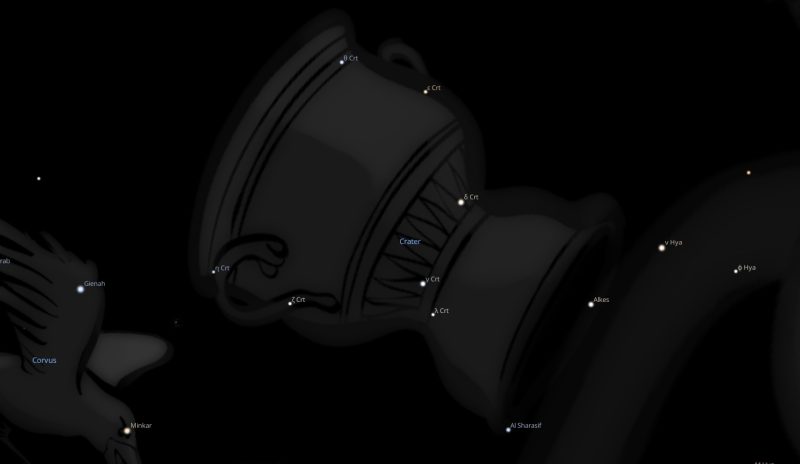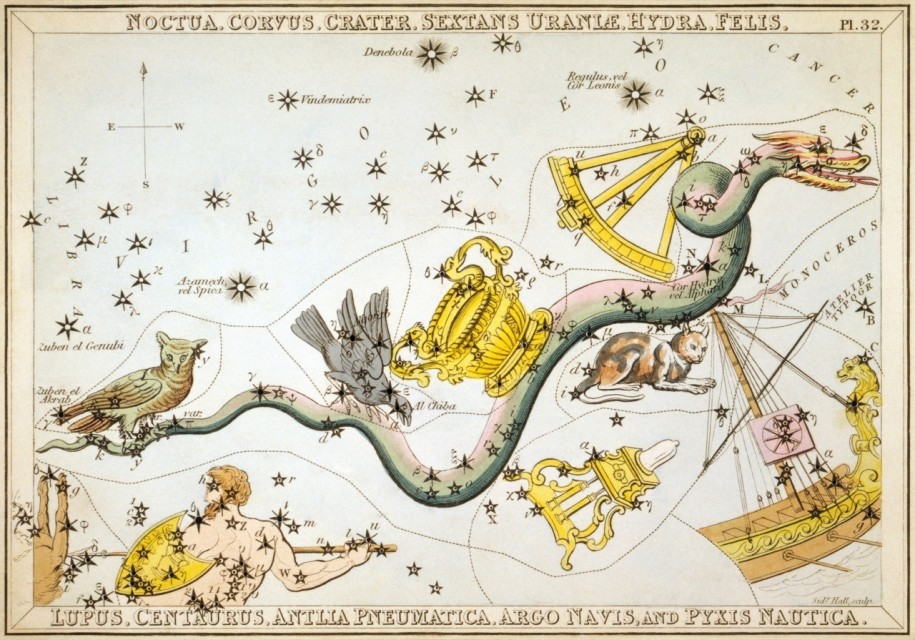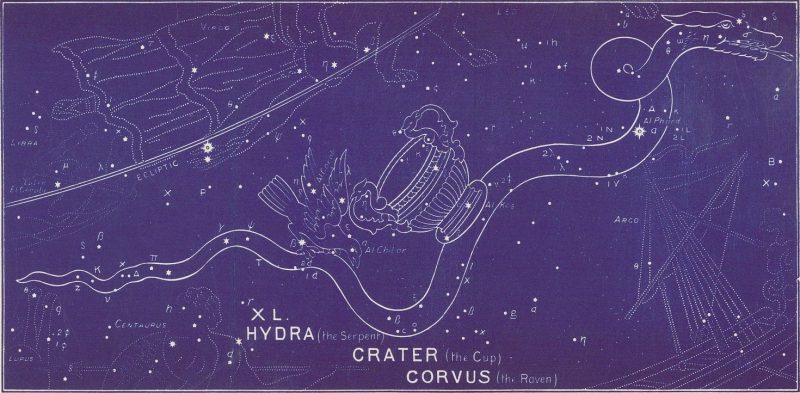FIXED STARS: Major Stars | 1000+ Stars | Constellations | About
Constellation Crater the Cup is a southern constellation bordering Virgo, Leo, Sextans, Hydra and Corvus.Crater is one of the 48 constellations listed by Ptolemy in the 2nd century and remains one of the 88 modern constellations. It spans 20 degrees of the zodiac in the Signs of Virgo and Libra.
Abbreviation: Crt
Genitive: Crateris
Crater Constellation Stars
| 2000 | 2050 | Star | Name | Sp. Class | Mag. | Orb |
|---|---|---|---|---|---|---|
| 23♍41 | 24♍23 | α Crt | Alkes | K1 | 4.08 | 1°20′ |
| 26♍15 | 26♍57 | ε Crt | K5 | 4.81 | 1°00′ | |
| 26♍41 | 27♍23 | δ Crt | Labrum | K0 | 3.56 | 1°40′ |
| 27♍28 | 28♍10 | κ Crt | Al Sharasif I | F4 | 5.93 | 1°00′ |
| 28♍33 | 29♍15 | β Crt | Al Sharasif II | A1 | 4.46 | 1°10′ |
| 28♍36 | 29♍18 | θ Crt | B9 | 4.70 | 1°00′ | |
| 29♍14 | 29♍56 | γ Crt | A9 | 4.06 | 1°20′ | |
| 04♎04 | 04♎46 | ζ Crt | G8 | 4.71 | 1°00′ |
Crater Astrology
Robson
CRATER. The Cup.
Legend. This constellation represents the cup given by Apollo to the raven (see CORVUS) to fetch water.
Influence. According to Ptolemy it is like Venus and in some degree like Mercury. It gives a kind, generous, cheerful, receptive, passionate and hospitable nature, with good mental abilities, but subject to apprehension and indecision. There is a disordered life full of sudden and unexpected events, and great danger of unhappiness, but usually some eminence. [1]
Noonan
The constellation gives good mental abilities, but there can also be sudden changes and unexpected events. [2]
Houlding
Crater the Cup, however, though seen here to be the source of elusive pleasure, is not itself an unfortunate constellation; rather it is viewed as a somewhat intangible font of great blessing. As the container of all-precious moisture, (the fertilizing element of life), the constellation is regarded as auspicious and has the capacity to bestow eminence and good fortune upon those who fall under its influence.
It is in keeping with the symbolism of this constellation, and that attached to bowls and cups generally, to suggest that it signifies success in pregnancy, creative matters, romantic unions or spiritual quests; and that it represents the sense of honour which accompanies successful completion of long-sought aims (as represented in the bestowing of cups as prizes in contests).
It offers a sense of satisfaction which may not be attained by indirect means or sinister motivations: its reward is available only to the deserving, those who have staked their claim through the honest efforts of their past. The constellation has particular significance for those whose wares are nourished by moisture or associated with water. [3]
Allen
Crater, the Cup… formed by several 4th- and 5th‑magnitude stars above the Hydra’s back, just westward from Corvus, and 30° south of Denebola, in a partly annular form opening to the northwest. This was long considered a part of the threefold constellation Hydra et Corvus et Crater; but modern astronomers catalogue it separately, Argelander assigning to it 14 stars, and Heis extending the number to 35.
In early Greek days it represented the Κάνθαρος, or Goblet, of Apollo, but universally was called Κρατήρ, which in our transliterated title obtained with all Latins, Cicero writing it Cratera; while Manilius described it as gratus Iaccho Crater, so using the mystic, poetical name often applied to Bacchus. In ancient manuscripts it appears as Creter. The Greeks also called it Κάλπη, a Cinerary Urn; Ἀργεῖον, Ὑδρεῖον, and Ὑδρία, a Water-bucket.
The Romans additionally knew it as Urna, Calix, or Scyphus, and, poetically, as Poculum, the Cup, variously, of Apollo, Bacchus, Hercules, Achilles, Dido, Demophoön, and Medea; its association with this last bringing it into the long list of Argonautic constellations.
Hewitt connected it with the Soma‑cup of prehistoric India; and Brown with the Mixing-bowl in the Euphratean myth of Istar-Kirke.
But any connection here would seem doubtful, although the Jews knew it as Cōs, a Cup. Hewitt also identifies it with “the Akkadians’ Mummu Tiāmut, the chaos of the sea, the mother of heaven and earth, and the child of Tiamut, the mother (mut) of living things (tia)”; but all this better suits Corvus.
In early Arabia it was Al Ma’laf, the Stall, — a later title there for the Praesaepe of Cancer; but when the astronomy of the Desert came under Greek influence it was Al Bāṭiyah, the Persian Badiye, and the Al Batinah of Al Achsasi, all signifying an earthen vessel for storing wine. Another title, Al Kās, a Shallow Basin, — Alhas in the Alfonsine lists, — has since been turned into Alker and Elkis; but Scaliger’s suggestion of Alkes generally has been adopted, although now applied to the star α. These same Tables Latinized it as Patera, and as Vas, or Vas aquarium.
Its more conspicuous stars, with χ and others in Hydra, twenty-two in all, formed the 10th sieu, Yh, Yih, or Yen, Wings or Flanks; and the whole constellation may have been the Chinese Heavenly Dog shot at by Chang, the divinity of the 9th sieu in Leo, which also bore that god’s name.
Astrologically it portended eminence to those born under its influence. [4]
Manilius
He will join your vines, Bacchus ‘grapevines for the production of wine’, in wedlock to your elms; or he will arrange them on props, so that the fronds resemble the figures in a dance or, allowing your vine to rely on its own strength, he will lead it to spread out its branches as arms, and entrusting you to yourself will forever protect you from the bridal bed, seeing how you were cut from your mother.
Whoever derives hence his birth and character will be attracted by the well-watered meadows of the countryside, the rivers, and the lakes. He will sow corn among the grapes and will adopt any other of the countless forms of cultivation that exist throughout the world as the conditions of the district will require. He will drink without stint the wine he has produced and enjoy in person the well-earned fruits of his labors; neat wine will incite him to jollity, when he will drown all seriousness in his cups. Nor only on the soil will he stake his hopes for paying his yearly vows he will also go in pursuit of the grain tax, and of those wares especially which are nourished by moisture or to which water clings. Such are the men to be fashioned by the Bowl, lover of all that is wet. [5]
Mathesis
Whoever is born with this constellation rising will love well-watered fields and springs or streams, or he will lead off rivers from their own riverbed to other places. He will be both a lover and a cultivator of vineyards, and one who will graft live shoots by inserting them into unfruitful trees, or who, by trimming boxwood trees, shapes them into large animals, or who makes the greenery of the colonnade into a circle with winding vines. He drinks wine with pleasure without any admixture [of water]. But if an aspect benefic stars [planets] decrees actions for him, he will trade in wet goods. [6]
Bullinger
This is no fabled wine-cup of Bacchus; but it is “The cup of His indignation” (Rev 14:10); “The cup of the wine of the fierceness of his wrath” (Rev 16:19). This is what we see set forth in this constellation. The Cup is wide and deep, and fastened on by the stars to the very body of the writhing serpent. The same stars which are in the foot of the Cup form part of the body of Hydra, and are reckoned as belonging to both constellations.
This Cup has the significant number of thirteen stars (the number of Apostacy). The two — Al Ches (α), which means the Cup, and (β) — determine the bottom of the Cup. [7]
References
- Fixed Stars and Constellations in Astrology, Vivian E. Robson, 1923, p.41.
- Fixed Stars and Judicial Astrology, George Noonan, 1990, p.71.
- Crater: The Cup, Skyscript.
- Star Names, Their Lore and Meaning, Richard Hinckley Allen, 1889, p.182-184.
- Astronomica, Manlius, 1st century AD, book 5, p.318-321.
- Mathesis, Julius Firmicus Maternus, 336 AD, viii 10.6-7.
- The Witness of the Stars, E. W. Bullinger, 1893, CRATER (the Cup).


